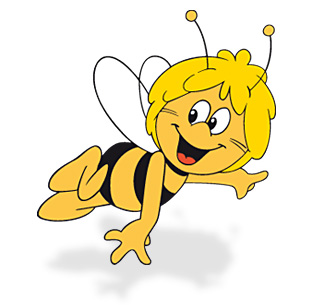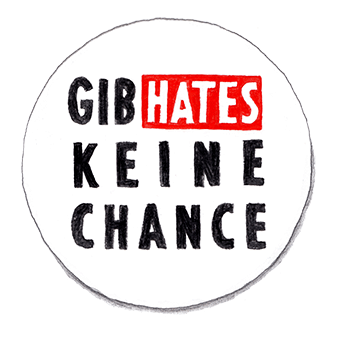Der Bär flattert in östlicher Richtung.
Leider können wir das Lied nicht hochladen, da unser Speicherplatz beschränkt ist.

Katinka Schröder schickte uns das neue ›Biene Maja‹-Lied und folgenden Text:
***
Neither Government Nor Farmers Are Looking Out for Bees. Someone Has To
by Kim Flottum
***
The Colony Collapse Disorder front has been more quiet than not for the past few weeks, plus, beekeepers are scrambling to get late summer work done before the crush of fall harvesting takes over their lives and some summer things don’t get done at all. Like making hay, it’s best to get bee work done when the sun shines and the weather cooperates. But commercial operations often must ignore that rule since they don’t get make-up days, do-overs or time-outs. When you have to move bees to be on a pollination crop, say pumpkins, on the first of July, you have to be there … you can’t offer the excuse, “Well, it’s raining here and I don’t want to stress my bees or make life miserable for my help.” The pumpkin grower doesn’t care one bit. He has flowers that need pollinating and they need it right now. So … you move bees in the rain.
And there are lots of management activities going on in preparation for harvest and to maintain the health of colonies. That last bit has become much, much more important in this post-CCD era. Beekeepers everywhere and operations of every size are taking better care of their bees because if you don’t, you don’t have bees.
Words of Wisdom From a Migratory Beekeeper
David Mendes, a commercial beekeeper from Florida is a good example. Dave’s been pollinating up and down the east coast for more than 30 years, moving bees to the wild blueberry barrens in Maine, to cranberries in Massachusetts, apples and blueberries in New Jersey, and is now moving most of his 7,000 colonies to California for almonds. If there ever was a migratory beekeeper, Dave is that person.
We’ve talked to Dave before about his bees and CCD and what’s changing in beekeeping. Dave is the VP of the American Beekeeping Federation, and a great spokesman for the industry in the halls of congress. He spoke at the Eastern Apiculture meeting in Kentucky last week, and I caught up with him afterwards. His experience and insights are telling and worth listening too, even if you are not a beekeeper because it reflects much about agriculture in general.
“Bees are suffering from something toxic”, says Dave, “if you take bees to cotton in Texas you’ll have high losses down the line. If you leave them in the woods and they don’t get into cotton, they’ll do fine. The same thing with citrus in the southeast, apples in the north east.
“If you say you’ve got virus problems, then the researches will listen. If you claim it’s a systemic pesticide problem, then politics gets in the way”, he said. “The pesticide thing is still anecdotal, even with the significant findings out of Penn State”, he said.
A major report is due out Monday at the American Chemical Society meeting in Philadelphia from Penn State telling of the horrendous amounts of pesticides found in samples taken from colonies in the CCD study program. Much of the report has already been released or discussed in various beekeeper meetings this year. Not surprisingly the three or four chemicals found in greatest amounts were the very chemicals beekeepers put in their hives to control mites. But 70-some other chemicals have been found that originate outside the hive. Our environment is loaded with this stuff, and bees bring them home by the pollen basket full.
So one of Dave’s new practices is a program of systematic replacement of the beeswax combs in his hives. This is relatively new in beekeeping because these combs represent an investment by the beekeeper and the bees, and replacement is expensive for both. However, keeping the inside of the hive fresh is healthy for the bees and healthy bees cost less to manage, so the replacement costs are another good investment. And that investment is paying off for those beekeepers that are already making the switch. Both commercial and hobby beekeepers see the difference right away in more productive colonies and healthier bees. “It’s a win:win situation”, said Dave.
He offered more advice at the EAS meeting.
7 Ways to Shield Your Bees from Pesticides
1. Pay attention to what’s going into your hives as far as mite treatments are concerned. Use the softest chemicals available that give good control.
2. If you are pollinating a crop, be aware of what chemicals your farmer is spraying, and especially what chemicals his neighbors are spraying.
3. Watch for the lethal three … corn, soybeans and cotton.
4. Ask your farmer what chemicals they used before your bees arrived to make sure there are not systemic chemicals in the nectar and pollen that your bees will bring home.
5. If you suspect your bees were exposed to any of these systemic chemicals, or have brought some home, bite the bullet and change out the combs in those colonies.
6. Make sure your colonies are well fed. Dave is feeding protein year round now, where he didn’t at all just a couple of years ago.
7. Know what your mite levels are.
The (Undocumented) Problems With Pesticides
Dave Mendes gave good information for beekeepers at this meeting, some of which is here, but what he had to say transcends beekeepers. He stressed that research is desperately needed to find the causes of CCD, but that the money isn’t coming nearly fast enough. He stressed that pesticides in and out of the hive are causing problems and that problem needed to be addressed too. He said that if a colony was healthy, well fed and in good shape, moving wasn’t a stress and wasn’t contributing to CCD or other problems.
He also said that beekeepers need to do a better job of monitoring pests in their hives, but scientists haven’t done enough to tell beekeepers what those levels really mean. And he said the whole world of pesticide registration is up-side-down. Right now, pesticide problems relate to what is called the LD-50 … how much it takes to kill (lethal dose – LD) half of the subjects in the study. What’s needed, he said, is a better idea of what sub-lethal effects have on not just bees, but people and other animals. And, do chemicals that are considered not toxic when applied correctly become toxic when applied incorrectly? Nobody knows, because the tests are only done at legal, correct application levels.
Colony Collapse Disorder isn’t caused by pesticides, we know that. But pesticides are killing bees … whether farmer-applied, community-applied, government-applied, or even beekeeper-applied. More must be done to control our exposure to these poisons … that’s the message Dave sent home with the beekeepers who heard him at the EAS meeting.
Photo Credit: Han v. Vonno / Istock
www.thedailygreen.com
(unbekannter Sänger / KF / BK / JS)



